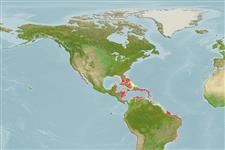Common names from other countries
>
Eupercaria/misc (Various families in series Eupercaria) >
Scaridae (Parrotfishes) > Sparisomatinae
Etymology: Sparisoma: Latin, sparus = a fish with a golden head + Greek, soma = body (Ref. 45335).
More on author: Valenciennes.
Environment: milieu / climate zone / depth range / distribution range
Ecologia
marinhas associadas(os) a recifes; intervalo de profundidade 1 - 12 m (Ref. 9710). Tropical; 33°N - 30°S, 89°W - 31°W
Western Atlantic: Bermuda, Florida (USA), Bahamas, and eastern Gulf of Mexico through central America to Santa Catarina, Brazil (Ref. 57756).
Tamanho / Peso / Idade
Maturity: Lm ? range ? - ? cm
Max length : 20.0 cm TL macho/indeterminado; (Ref. 7251); common length : 15.0 cm TL macho/indeterminado; (Ref. 5217)
Espinhos dorsais (total) : 9; Raios dorsais moles (total) : 10; Espinhos anais: 3; Raios anais moles: 9. Front of upper jaw has horizontal canine-like tusks. 2 scales between bases of pelvic fins (Ref. 26938). Drab-phase fish are olivaceous to yellowish brow, finely speckled with pale dots, many are conjoined; base and axil of pectoral fins broadly blue-green. Terminal-phase males are greenish brown with faint pale dots, some scales with reddish edges; irregular orange-red markings on opercle; a blackish bar at pectoral base; a broad blackish border posteriorly on caudal fin (Ref. 13442).
Mostly found in seagrass beds in shallow, protected waters. Feeds primarily on epiphytes and seagrass blades, leaving crescent bite marks. Darts into seagrass when frightened (Ref. 9710).
Life cycle and mating behavior
Maturities | Reprodução | Spawnings | Egg(s) | Fecundities | Larvas
Robins, C.R. and G.C. Ray, 1986. A field guide to Atlantic coast fishes of North America. Houghton Mifflin Company, Boston, U.S.A. 354 p. (Ref. 7251)
Categoria na Lista Vermelha da IUCN (Ref. 130435)
CITES (Ref. 128078)
Not Evaluated
Ameaça para o homem
Reports of ciguatera poisoning (Ref. 30303)
Utilização humana
Pescarias: de interesse potencial; Aquário: Espécies comerciais
Ferramentas
Relatórios especiais
Descarregue XML
Fontes da internet
Estimates based on models
Preferred temperature (Ref.
115969): 26.1 - 28.2, mean 27.5 (based on 693 cells).
Phylogenetic diversity index (Ref.
82804): PD
50 = 0.5000 [Uniqueness, from 0.5 = low to 2.0 = high].
Bayesian length-weight: a=0.01072 (0.00695 - 0.01651), b=3.13 (3.00 - 3.26), in cm Total Length, based on LWR estimates for this species & Genus-body shape (Ref.
93245).
Nível Trófico (Ref.
69278): 2.0 ±0.0 se; based on diet studies.
Resiliência (Ref.
120179): Elevada, tempo mínimo de duplicação da população menor que 15 meses (Preliminary K or Fecundity.).
Fishing Vulnerability (Ref.
59153): Low vulnerability (10 of 100).
